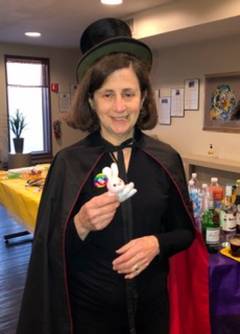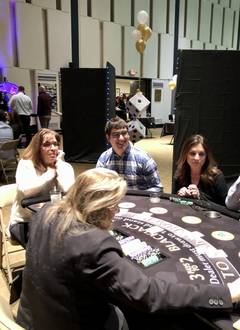Enough (Rosh Hashanah Day 2 2023)
09/18/2023 09:46:12 AM
Rabbi Ben Goldberg
| Author | |
| Date Added | |
| Automatically create summary | |
| Summary |
Last fall, you may remember, we at KTI held our long-delayed tag sale. Back in the spring of 2020, knowing that many people were using the extra time at home to clean out unneeded belongings, we invited people to bring their tag sale items to the synagogue, planning, it turned out naively, to hold our biannual tag sale as scheduled in the fall of 2020. Well, people plan and God laughs. We kept delaying the sale, and stuff kept accumulating in the basement of this building. Finally, last fall, with lots of volunteer effort from people across the community, we brought more than 2 years of accumulated treasures up out of the basement, and laid them out for a very successful tag sale.
It was quite something, viewing an entire community's cast-off possessions: clothing, household items, furniture, odds and ends and more. The sheer amount of items felt overwhelming. It occurred to me: every one of these thousands of items was once desired, purchased, and used by someone in our community. And yet, here they all are, in usable condition, yet cast off. To be sure, repurposing these items through the tag sale is certainly better than sending them to a landfill forever. But it made me wonder: how did we get here? Were each of these items really needed at the time they were purchased? Were they used to the fullest extent possible before they were discarded? Or were they merely replaced with a new must-have item that will end up at the next tag sale?
We live in a world awash with material possessions, as the social hall, overflowing with stuff, made clear. Certain economic and technological developments have sent our American consumer culture into overdrive: online shopping with free and fast delivery, and that very tempting “buy now” button; credit cards, which allow us to easily spend beyond our means and avoid the feeling that we are actually spending money; and planned obsolescence, where consumer goods are only meant to last for a short time and often cannot be repaired economically or at all.
Yet, the real reasons why we buy so much stuff are deeper than any of these developments. We might think we buy things we don’t really need because we’ve been duped by clever marketers. And while marketing and advertising are powerful forces, they aren’t that powerful. One sociologist suggests that we actually buy stuff as a way to assert our belonging to a particular group. We see our friends or neighbors or people on social media buying something; we want to be like them, and so we buy it ourselves.Those goods serve a social and identity function, beyond whatever purpose they are ostensibly for.
This creates the phenomenon of lifestyle creep, where people keep buying more and more in an attempt to keep up with their peers. I remember in my last year of rabbinical school, my cohort met with a rabbi and tax accountant (yes, the same person) who warned us: “compared to your student existence, with the jobs you are about to start, it may suddenly seem like you are making a lot of money. Don’t worry,” he reassured us: “you’ll spend it!”
And spend it we do, on all kinds of things. Not for nothing was clothing the biggest category at our tag sale: the rise of fast fashion has flooded the world with inexpensive, and inexpensively made, clothing, meant to be worn only a few times and then replaced with something more on-trend. Indeed, American consumers buy more than five times as much clothing as we did in the 1980s.
A related trend is the rise in the so-called reverse supply chain of returned goods, the value of which is said to be approaching a trillion dollars annually. We might imagine that our returned goods are simply put back on the shelf to be sold as new to someone else, but the reality is actually much more complex. I encountered this myself over the summer. I had bought a few large tubs of cream cheese from Costco which I thought I would need. When it turned out I didn’t need them after all, I decided to take advantage of Costco’s famously generous return policy. The clerk at the desk processed the return, but then told me: “You know we just throw this out, right?”
I was a bit taken aback, but then, I thought about this situation from the clerk’s perspective. She must stand there all day and throw away perfectly good food, all to avoid liability on Costco’s part. As I left the store, I thought: was a return the only option here? Could I have found a way to creatively use what I had purchased, rather than send it to the trash?
Jewish sages have long recognized the problems of consumerism, even before modern conditions exaggerated the phenomenon. Thousands of years ago, the sage Rabbi Aivu taught: no one leaves this world with half their desires fulfilled. Someone with one hundred wants two hundred; someone with two hundred wants four hundred. As my colleague Rabbi Danny Pressman put it: “the more you have, the more you want, and the horizon of your desires recedes unattainably before you. No matter how hard you pursue that other half, it keeps retreating into the distance. What a wonderful formula for unhappiness.”
Indeed, our sages teach: “the more possessions, the more worries.” Pretty much anything we buy needs to be cleaned, maintained, or safely stored in a place we’ll remember. And the more items we acquire, the more to keep track of, the more “what ifs” to worry about. I suspect that stuff piles up, in part, because it feels too overwhelming to pay attention to it all, or to make that seeming-consequential decision to finally get rid of something. And, a second kind of worry increases with possessions: the novelty of whatever we bought tends to wear off quickly, and soon we’re back where we started, worrying about the next thing to buy. As Don Draper, the consummate advertiser from TV’s Mad Men, says: “What is happiness? It's a moment before you need more happiness.”
So buying more and more doesn’t make us happy, at least not in the long-term. And not for nothing, it’s no good for our planet either, with its limited resources and delicate climate. So what might make us happy? Our ancient sages had an answer: “Who is wealthy? Those who are happy with their portion.” This advice seems counter-intuitive. In fact, I’ve heard it joked that it’s backwards: those who are happy with their portion are the wealthy! But think about it: no matter how much we have, we could always have more. And so the real way to feel rich is not to acquire more, but instead to truly appreciate what we already have.
It might sound like this advice totally discourages any ambition, any attempt to get more. But I don’t think that’s what our sages meant. We might think of our portion as our potential, what is ours to have. Yes, we should strive to reach our fullest potential, both economically but also morally and spiritually. However, no matter who we are, there will be limits to that potential. And when we reach those limits, rather than trying to surpass them, instead, our tradition invites us to find happiness in having reached that potential, no more and no less.
Nor does our tradition expect a strict asceticism of us. The general view among Jewish sages has been that the Torah forbids enough as is, and we should enjoy what is permitted to us. Indeed, one ancient sage taught that in the next world, we will be called to account for all of the things we could have enjoyed, but chose not to. So Judaism does not expect us to renounce all of our possessions, but rather, to acquire and use our possessions in an intentional, sacred manner.
How do we do this? The Jewish masters of ethical refinement lay out a path, known as histapkut. Histapkut is related to the Hebrew word for “enough,” and means something like contentment or simplicity, or learning to live with what we have right now, rather than constantly striving for more.
An 18th century sage known as the Vilna Gaon laid out a three step path toward histapkut. The first step, easier said than done, is simply to acquire less. This requires us to become much more mindful consumers, to disrupt ingrained habits. Between the stimulus of an acquisition opportunity and the response of buying it, we insert a moment where we ask ourselves: Do I really need this? Or would I buy this merely because I saw that someone else had it? Could I actually make do without it? What deeper need might this purchase fulfill, and might I fulfill that need in a healthier way? What will ultimately happen to this item, and can I justify that outcome? At this stage, you still feel those pangs of desire, but act on them in a more self-aware, deliberate way.
This applies of course to new items we might acquire, but also to things we already have. Over the summer, I engaged in a bit of light cleaning out, getting rid of things that I no longer needed. I imagine many of you do this periodically. But in her 2017 book “The Gentle Art of Swedish Death Cleaning: How to Free Yourself and Your Family from a Lifetime of Clutter,” Margareta Magnussen suggests that the pile-up of items in many people’s homes connects to much broader issues of life and death. She writes, in a plainspoken, Scandinavian manner: “Some people can’t wrap their heads around death. And these people leave a mess after them. Did they think they were immortal?”
Recognizing that our possessions won’t always be ours brings up the uncomfortable specter of death, one that many people avoid by just letting stuff pile up as the years go by. In my practice as a rabbi, I’ve seen how the grief following a death can be compounded by the need to sift through a lifetime’s worth of someone else’s possessions. Magnussen is on to something: one of the best ways to enjoy our own lives, as well as demonstrate our love for those we leave behind, is to pare down our possessions and not leave a mess for someone else to clean up.
The second of the Vilna Gaon’s steps is to focus on actually being happy with what you already have. This is an attitude to be cultivated independent of how much or how little you objectively possess. We can do this by reorganizing our priorities away from the physical to the spiritual. While the first step was about frugality and resisting desire, this stage is about abstinence and the reduction of desire in the first place. We look at something we might possess and say: no thank you. I don’t even want this. It’s like the purported remark of the philosopher Socrates as he strolled through the marketplace of Athens: “Who knew there were so many things that I could do without?”
Judaism embeds this wisdom into many of our basic practices, like Shabbat and the dietary laws. Through these practices, we habituate ourselves to say “no, thank you” to things we might otherwise enjoy. And I have found that this kind of abstinence at first feels restricting, but can actually be liberating. Setting aside one day a week to avoid commerce and other mundane activities puts me in a more elevated state of mind, where I can simply enjoy what already exists, rather than trying to create something new. This is the “Shabbat Shalom” we wish each other: a day where we can be at peace, content with what is, not wanting more.
The final step is when we have completely obliterated desire. There is nothing more we could possibly want, and we can be satisfied with very little, because our focus is entirely on the joyful service of God. Few reach this saintly level, but it points us toward the ultimate connection between contentment and faith.
Much of our worry–about social status, about life’s “what ifs”--stems from insufficient faith that the Master of the Universe will provide enough for us at any given moment. As the Jewish spiritual teacher Alan Morinis writes: “Being content means accepting that you have been allotted everything you need for the present, according to a wisdom that is higher than anything your human mind can assess.” Such a faith is by no means easy. Yet, if we can adopt the attitude that whatever we are experiencing now is just a piece of a much larger story, if we try to see how whatever we have just might in its own way be enough, we can find contentment, even joy, in whatever circumstances.
This humble submission to a power and wisdom greater than our own is in large part the meaning of Rosh Hashanah. We acknowledge that so much is out of our control, yet resolve to live well anyway. And we pray: b’sefer chayim bracha v’shalom u’farnasa tova…Inscribe us, God, in the book of life, blessing, peace and good livelihood. I love that Jewish liturgy is so grounded in the realities of life that we are not too embarrassed to ask for a good material livelihood. This year, though, I’d like to suggest that we understand this prayer differently: not as asking for a good livelihood, but rather a good-enough livelihood, a histapkut livelihood: enough resources to meet our real needs and some of our desires, always keeping in mind that, ultimately, it’s all just stuff.
The story is told of an Eastern European Jew who immigrated to America and made it big. He visited the old country and paid a call to a famous rabbi, renowned for his piety and refinement. Entering the rabbi’s simple apartment, the visitor was struck by how sparsely it was furnished. “Where’s all your furniture?” the visitor asked the rabbi. “Where’s yours?” asked the rabbi back. “Oh, I’m only passing through here for a little while,” answered the visitor. “Me too,” responded the rabbi.
As we pass through this new year, may we each be blessed with what feels like enough. Shana tova.
Sat, November 1 2025
10 Cheshvan 5786
Photo Gallery
Photo Albums
Upcoming Events
-
Saturday ,
NovNovember 1 , 2025Dror Israel Shabbat
Shabbat, Nov 1st 11:30a
Dror Israel Shabbat Dror Israel’s Mirit Sulema, along with two leaders of the Arab Youth Movement NOAL, Tal Tunik and Shadi Habiballa, will speak during a Kiddush lunch about their important work with Arab Israeli youth and bringing Jewish, Arab, and Druze youth together. Saturday, November 1st, approx. 11:30am KTI Social Hall "We eat together, laugh together. We talk about what we think of each other, and what will help bring peace.” RSVP Appreciated -
Saturday ,
NovNovember 1 , 2025KTI Gala - A November to Remember Digital Journal
Motzei Shabbat, Nov 1st 7:00p to 10:00p
-
Saturday ,
NovNovember 1 , 2025KTI Gala - A November to Remember
Motzei Shabbat, Nov 1st 7:00p to 10:00p
Saturday, November 1, 2025, 7:00 PM - 10:00 PM Harrison Meadows -
Wednesday ,
NovNovember 5 , 2025Rabbi, May I? Modern Responsa
Wednesday, Nov 5th 10:00a to 11:30a
Wednesdays, 10 - 11:30 AM, KTI Library Ever since Abraham’s famous argument with God, Judaism has been full of debate. Moses and Korah, David and Nathan, Hillel and Shammai, the Vilna Gaon and the Ba’al Shem Tov, Spinoza and the Amsterdam Rabbis . . . the list goes on. No wonder that Judaism cherishes the expression machloket l’shem shamayim, “an argument for the sake of heaven.” Beyond their historical importance, what makes these disputations so compelling is that nearly all of them, regardless of their epochs, are still being argued. The parade of characters spanning three millennia of biblical, rabbinic, and modern disputation reflects the panorama of Jewish history with its monumental political, ethical, and spiritual challenges. This series will examine Jewish responses to exile from the biblical period to our modern day. Considering texts from all genres of Jewish literary creativity, we will explore how the realities and iterpretaions Join as we re-open these timeless debates that lead us to the core of 3,000 years of Jewish conversation. • Justice: Abraham vs. God (October 19) • Holiness and Authority: Moses vs. Korah (November 9) • Inclusion: The Five Daughters vs. the Twelve Tribes (November 30) • Accountability and Morality: David vs. Nathan (December 21) • Resistance: Ben Zakkai vs. the Zealots (January 18) • Law: Hillel vs. Shammai (February 15) • Spirituality: The Vilna Gaon vs. the Baal Shem Tov (March 15) • Boundaries: Spinoza vs. the Amsterdam Rabbis (April 19) • Religious Evolution: Geiger vs. Hirsch vs. Frankel (May 10) • Zionism: Herzl vs. Wise (May 31) -
Thursday ,
NovNovember 6 , 2025Coffee with the Rabbi
Thursday, Nov 6th 8:00a to 9:00a
Start your morning with some caffeine and casual or meaningful conversation! Join Rabbi Goldberg for a Coffee Chat! Stop by Rye Ridge Starbucks any of the following Thursdays, between 8-9am: June 12 and 26 July 10 and 24 August 7 and 21 September 4 and 18 October 16 and 30 November 6 and 20 December 4 and 18
Privacy Settings | Privacy Policy | Member Terms
©2025 All rights reserved. Find out more about ShulCloud






